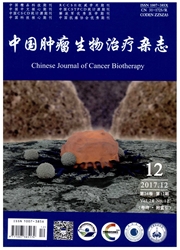

 中文摘要:
中文摘要:
目的:观察端粒酶反义寡核苷酸、As2O3,对肝癌细胞生长的影响,寻找低剂量、低毒、高效、安全的抗肝癌新疗法。方法:自行设计合成靶向端粒酶模板区的20nt硫代反义寡核苷酸,观察端粒酶反义寡核苷酸与As2O3,对肝癌细胞端粒酶活性的影响及两者协同对肝癌细胞生长的影响,采用H-E染色、流式细胞仪及DNA琼脂糖凝胶电泳观察端粒酶反义寡核苷酸与As2O3对肝癌细胞的凋亡诱导作用,以流式细胞术检测肝癌细胞的Fas、Fas-L、bcl-2蛋白的表达。结果:5μmol/L的端粒酶反义寡核苷酸作用24h可显著抑制肝癌细胞端粒酶活性(P〈0.01);肝癌细胞端粒酶活性被抑制后对As2O3,诱导凋亡的敏感性显著增加,表现为低浓度、短时间即可诱导肝癌细胞凋亡(P〈0.01),端粒酶反义寡核苷酸与As2O3,对肝癌细胞的凋亡诱导作用是通过Fas、Fas-L途径实现的。结论:抑制肝癌细胞端粒酶活性可显著增强其对As2O3,诱导凋亡的敏感性,减少砷剂用量,两者协同有潜在的临床应用前景。
 英文摘要:
英文摘要:
Objective: To observe the effect of telomerase-antisense DNA on apoptosis of hepatoma cells induced by arsenic trioxide, in an effort to look for a new anti-hepatie eaneer agent with high effieieney, low eytotoxieity. Methods. We designed and synthesized a 20nt telomerase-antisense DNA targeting telomerase template and observed its influence on the telomerase activity of hepatoma cells. H-E staining, flow cytometry, and DNA agarose electrophoresis were used to study the preventive effect of telomerase-antisense DNA on hepatoma cells apoptosis induced by arsenic trioxide. Flow cytometry was used to detect the expression of Fas, Fas-L, and bcl-2. Results: Telomerase-antisense DNA (5 μmol/L) effectively inhibited the telomerase activity of hepatoma cells after 24 hours (P 〈 0.01 ). When telomerase activity was inhibited by telomerase-antisense DNA, the hepatoma cells became more sensitive to arsenic trioxide induced apoptosis, which was induced through Fas and Fas-L pathway. Conclusion: Inhibition of telomerase activity can obviously increase the apoptosis rate of hepatoma cells induced by arsenic trioxide, therefore reducing the quantity of the latter in treating HCC, indicating a future for the combined application of both in clinical practice.
 同期刊论文项目
同期刊论文项目
 同项目期刊论文
同项目期刊论文
 期刊信息
期刊信息
